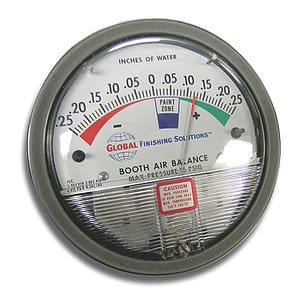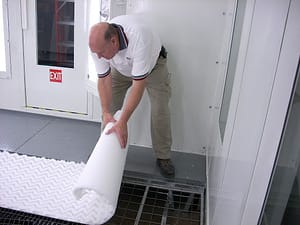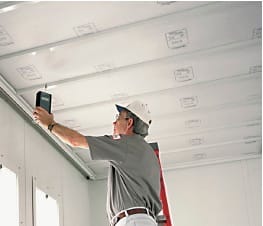
“Is there a “magic number” on the manometer at which paint booth filters should be changed?”
While it sure would be nice if there was a universal ‘change-your-filters-now’ number that would make everyone’s maintenance a lot easier to manage, there’s just too many variables in paint booth design that come in to play. However, there are some general guidelines for most finishing operations that you can use to better plan out your paint booth filter changes and get more life out of your filters.
Here’s the answer that our experts came back with!

All fan units are designed to operate within a range of resistance, that includes the ductwork, plenum and filters. Without the exact fan curve data that should have been supplied in the operator’s manual for a particular booth, the best one can do is base the change out resistance on industry “norms”.
The exhaust filters of most spray booths are designed to be changed at approximately 0.5”-0.75” water column, but with variable frequency drive systems this may be extended to 1.0” or beyond for a single-stage exhaust filter. On intake filters, the change-out final resistance depends in part on the type of booth: non-pressurized or pressurized; and with pressurized booths, whether it is a recirculation or has independent supply and exhaust fans.

Recirculation filters would typically be changed at 0.5”-1.0” water column dependent on fan capability. Air make-up filters in a separate fan unit would be changed similarly. For diffusion filters in a pressurized booth, a Preventive Maintenance schedule is probably the most preferred method of maintenance: once per year for booths that have MERV8 or higher supply air filters, and twice per year for filters with lower efficiency ratings.
Again, these are generalized and not specific to the equipment in use at this application. More critical than any speculative or default method of determining filter change parameters would be to consult the operator manual or the manufacturer for the specific equipment involved.
One of the best ways to highlight your business is through a story that you can share across your online platforms. It humanizes your business and shows that your business can make a meaningful impact. Your testimonial would be used as a project profile on the GFS Booth Blog and can be shared on your website and/or social media channels.
Complete this form and we’ll be in touch to showcase your company.

Shop a variety of GFS aftermarket products, including booth protection products and mobile accelerated curing units. And enjoy the convenience of fast and free ground shipping throughout the contiguous United States.

Located at GFS’ headquarters in Osseo, Wisconsin, the Center for Excellence is an innovative facility featuring an automotive refinish training center, as well as a separate space dedicated to technical product training.

GFS is continuously searching for talented, ambitious individuals to join our team. We aim to provide our employees with every opportunity to make an impact on the company and find their niche along the way — weather in a production, field services or an office position.